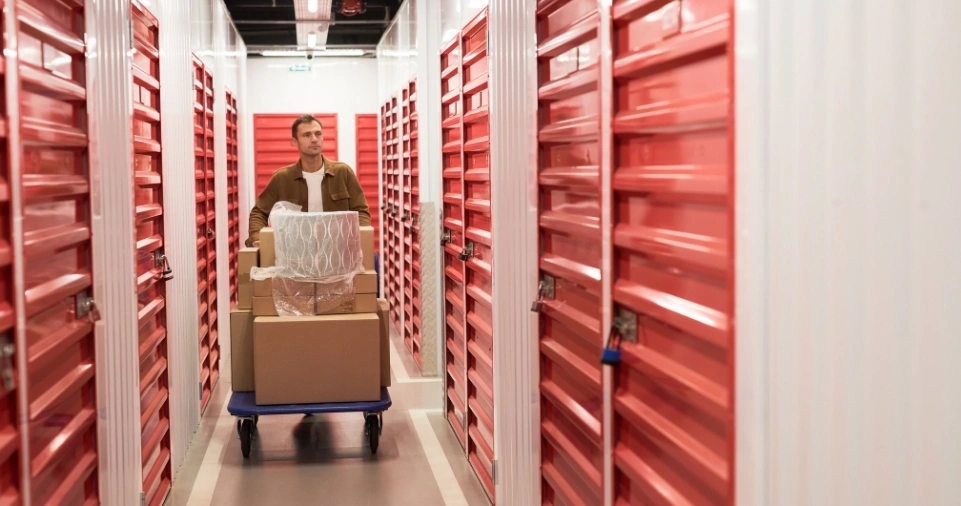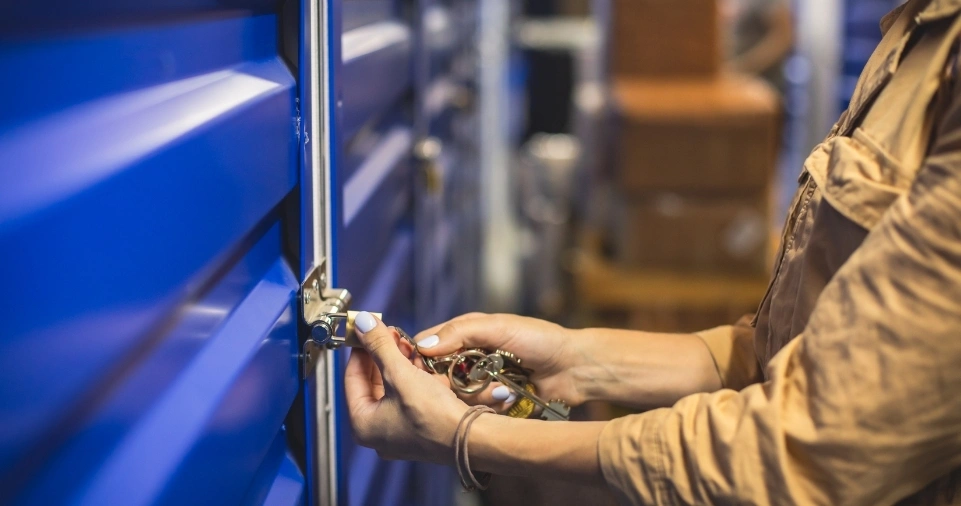When I first started exploring investment opportunities back in 2025, I was constantly searching for ways to achieve portfolio diversification and generate passive income. Like many beginners, I wondered how to invest wisely without taking on excessive risk. That’s when I discovered self storage – an asset class that combines stability with impressive cash flow potential.
The industry has seen remarkable growth, with 4,536 properties in development across the nation, driven by ever-increasing demand. What makes this sector particularly attractive is the potential for high ROI, especially when you understand the fundamentals of how self storage facilities operate.
The journey into self storage investment requires understanding what sets it apart from traditional real estate investments. Unlike typical commercial real estate ventures, this fast-growing sector serves space-strapped customers who need a secure place to store their excess household items.
The numbers tell a compelling story: nearly 1 in 10 American households utilizes one of approximately 50,000 self-storage facilities nationwide, generating over $22 billion in annual U.S. revenues. The total rentable space now exceeds three times the size of Manhattan island, demonstrating the massive scale of this industry.
What initially caught my attention was the unique business model that differentiates self storage from other property types. These facilities can thrive in unglamorous locations along noisy roads or on the outskirts of town – places where other businesses might struggle. Tenants typically pay little or no deposit and can leave at a moment’s notice, yet the sector has demonstrated robust performance and sustained growth even during recession periods.
What is Self Storage Investment?
Self storage investment represents a specific type of real estate investment where you invest your funds into self storage facilities and earn a return through rental income from storage units. Your customers can range from individuals managing personal belongings to small and medium-sized businesses needing inventory space. The beauty of this investment lies in its flexibility – you can become an active investor by operating and managing the facility directly, or choose to be a passive investor with no involvement in daily business operations.
The rental income stream comes from renters who may need storage space for a short period or long term, depending on their circumstances. As long as a tenant keeps their belongings in the storage unit, you continue earning consistent revenue. There are seven unique paths to enter this market:
- Stairstep from Small to Large
- Capital-Raiser
- Deal-Finder
- Go Big
- Get a Job
- Hire a Coach or Mentor
- Invest Passively
Each path offers different levels of involvement and capital requirements.
Benefits of Self Storage Investment

Why Experts Consider It a Flourishing Business
Experts universally view self storage investment as a flourishing business and profitable investment opportunity. After analyzing numerous deals during my time as a Director of Acquisitions for multifamily properties, I discovered why this sector stands out.
There are 6 reasons why investing in a self storage business makes financial sense:
- Low risk
- High demand
- Stable income stream
- Economic durability
- Low maintenance
- Flexible business model
These characteristics create a compelling case for both new and experienced investors.
Low Risk Profile
Every business carries some risks that can impact your return on investment, but self storage stands out for its remarkably low operational costs and consequently lower business and operating risks. These low operating costs translate to high profit margins, allowing you to manage short-term revenue fluctuations more effectively than most other ventures.
When a tenant breaks rules or fails to pay rental charges, you can mark a lien against their property. This means that in cases of non-compliance, you can auction or sell their belongings to compensate for your dues.
The demand for storage units isn’t seasonal, which provides remarkable stability. If you’re in a good location and deliver excellent customer service, you’ll consistently find tenants. All these factors combine to make it a lucrative business with manageable downside scenarios.
Growing Demand Across Multiple Segments
The sector experiences growing demand from diverse groups. From students needing temporary space to large and small businesses requiring inventory storage, everyone needs a storage unit at some point. This high demand allows facilities to operate at capacity, maximizing rental income. Higher rental income directly leads to high revenue and high profits, ensuring you get the best value for your investment.
Investors can diversify income streams from a storage unit through attractive add-ons like loading and unloading equipment or vending machines, while simultaneously increasing tenant capacity. This approach ensures a steady cash flow for investors throughout various market conditions.
Stable Income Stream Advantages
One of the primary benefits of self storage investment is the potential for a stable income stream. Storage units for sale remain in high demand, offering consistent rental income from tenants. Unlike other real estate investments that may experience significant fluctuations in occupancy rates, self storage units often maintain high occupancy levels due to the ongoing need for storage space across economic cycles.
Economic Durability Through Downturns
Self storage has proven resilient during tough times, including the 2008 financial crisis and the Covid-19 pandemic. It’s arguably one of the most thriving businesses in today’s world. The low operating costs combined with decent profit margins make it a remunerative business for investors seeking stability. The economic durability offered by this industry makes it an ideal investment for risk-averse investors and an excellent passive source of income for portfolio diversification.
Low Maintenance Requirements
Self storage infrastructures are remarkably simple and easy to maintain. Once you build a storage facility, you don’t usually need to spend frequently on improving or enhancing its infrastructure. All you need is a secure space with good lighting, a security system, and fire protection equipment to get started.
When a self storage facility uses self storage management software, operations can be automated, dramatically reducing the need for on-site staff. These facilities reap the efficiency and cost benefits of automation. You can automate several functions including Profile management, Billing and invoice management, Storage unit booking, Move-ins and move-outs, and Unit locks out on overdue payments.
Flexible Business Model Benefits
The self storage business model is remarkably flexible to power through tough times. You can start a storage facility from an empty building and scale once you start earning enough profits. Besides self service kiosks, you may also add valet storage to increase the scope of services and use management software to manage valet storage efficiently.
Many storage facilities offer a valet service – essentially truck rental services as an add-on to help renters move their belongings. The flexibility of this business model helps investors get the best ROI in all economic situations. During the boom, you can focus more on seeking storage units for sale, whereas during a recession, there’s high demand for rental units during downsizing.
Fragmented Ownership Creates Opportunities
Approximately 75% of self-storage owners own only one or two facilities. These mom-and-pop owners don’t utilize industry best-practices like management software, online rentals, and internet advertising. What does this mean for self-storage investors?
It presents an incredible opportunity to acquire facilities and improve operations through online marketing, better collections, and adding ancillary income like tenant insurance. The result is higher Net Operating Income and an increase in value. The facility can then be refinanced or sold and the process repeated.
Lower Expense Ratio Than Other Real Estate
The expense ratio for a self-storage facility is roughly 35%. This means for every dollar of revenue about $0.35 is used to pay expenses. The remaining $0.65 is the Net Operating Income. This ratio is considerably lower than other types of real estate. Why is this? There are no leaky toilets, broken fitness machines, or troublesome tenants. The Capex list is short and an owner can reasonably anticipate when Capex items will need to be replaced, like roofs and doors. In other words, self-storage has fewer unexpected expenses resulting in stable cashflows for the owner.
Fair Housing Laws Advantage
Fair Housing Laws are laws created by the Federal Government to protect people from housing discrimination based on race, sex (gender), disability, color, religion, familial status (children), and national origin. These laws apply to every owner involved in the sale or rental of housing, not just real estate brokers or property management companies.
Penalties for violating Fair Housing laws can total into the thousands of dollars. These laws don’t apply to self-storage because self-storage doesn’t offer housing for sale or rent. There are no eviction moratoriums because self-storage owners don’t evict tenants for past due rent. The result is an owner who doesn’t have to fear the complaints of tenants, and the freedom to operate a business as it was intended.
Month-To-Month Flexibility
When someone rents a unit, they sign a month-to-month rental agreement, not a long-term lease. If rents are increasing in your market, you can raise rents to capture that potential revenue. Tenants are typically sticky, meaning they most likely won’t move out due to a nominal increase in rent.
In other words, a tenant isn’t likely to get so upset about a $5 dollar a month rent increase, that they rent a truck and call friends to help them pack their unit. Where would they go? Down the road where another facility is charging the same amount? That’s unlikely.
No Evictions Required
An eviction can be a lengthy and costly process, and often includes a heartbreaking story about job loss, a family breaking up, or unexpected medical bills. No one wants to be the big, bad landlord who kicks people out on the street when they can’t afford to pay. Self-storage operators don’t foreclose or evict customers. They auction stuff, and that stuff is usually unwanted.
SBA Lending Advantages
Self-storage is the only real estate asset class that the Small Business Administration (SBA) will lend on. Like an FHA loan where a homebuyer can put as little as 3.5% down, an SBA loan only requires a 10% down payment. In contrast, most other types of self-storage loans may require a buyer to put 25 to 30% down.
The SBA will provide funds to cover renovation or Capex costs, helping small investors with the upfront capital needed for repairs. There are some trade-offs with SBA loans, so it’s advisable to look at all financing options before deciding. The result is the ability to invest in real estate as an operating business and have the help of the SBA to get started.
Economic Drivers Behind Success
Two primary factors influence the business. First, people continue to acquire things that can’t be consumed – furniture, toys, numerous knick-knacks – and, for various reasons, they are hesitant to throw these items out. The recent recession hurt the sector only slightly; displaced homeowners often moved to apartments or smaller homes and still needed to store excess household items.
Second, despite the short-term nature of the rental contracts, people are reluctant to finally deal with – and throw out, or at least clean out – the items they’ve placed in storage. Stored stuff is like a bank deposit – it usually stays where it is. Estimates are that one-third of storage space is filled with items that have been there for over three years.
Rapid Adaptability
Because the tenant base at these facilities is large, owners are protected from the long-term vacancies that can sometimes occur in other commercial real estate categories. The short-term nature of the rentals also allows owners to quickly react to market conditions.
Stable Cash Flow Characteristics
People use self-storage for many different reasons, including household downsizes, renovations, relocations, military posts, and for holding business records. Some of these motives become more prevalent during economic downturns, lending a counter-cyclical feature to the sector.
Moreover, because people are slow to leave these facilities once they’ve rented space, turnover is less of an issue than the short-term contracts might lead one to expect. Finally, the large number of rentable spaces in most facilities also means that owners are not vulnerable to large swings in vacancy rates.
Moderate Management Chores
Self-storage facilities are relatively low-maintenance; a clean sweep after a tenant has vacated and the space is ready for the next renter, and there is typically no need for tenant improvements or leasing commissions. Until the recent recession, operators rarely had to do much marketing; that has now changed, and knowledge of internet marketing techniques is becoming a big factor. A manager usually needs to be on-site during the day to handle new leases, and security guards, alarms, or cameras are usually employed during evening hours.
Fragmented Market Dynamics
Nearly 80% of self-storage properties remain in the hands of small, independent investors. The sector’s solid past performance has begun to capture the attention of large institutional investors. Larger properties in particular are increasingly the subject of interest from institutional buyers, including the larger self-storage companies that run themselves as real estate investment trusts (REITs).
Risks of Investing in Self Storage

Understanding Risk Factors
Nothing is ever completely risk-free, and it’s important to understand the key self storage investment risks to mitigate them effectively. There are 3 common risks you may face when investing in this industry: Tricky market positioning, the need for active management, and Risk of oversupply. While self storage remains a lucrative business, you can only leverage its pros if you position your business right.
Tricky Market Positioning Challenges
Finding the right market for your storage facility and securing a place in the market is tricky. Several factors make market positioning a challenge: Locating competitors, Understanding customer demands, Building the right mix of units, Offering the amenities that renters want, and Finding an ideal real estate space in a busy location. If you do not analyse these factors thoroughly and execute the right market positioning strategy, you may not get the desired results from the storage facility.
Active Management Requirements
Contrary to common assumption, self storage management is not completely hands-off. Even if you install the latest self storage management software and automate most functions, as mentioned previously, you still need active management to oversee some business operations. Ensuring that the security systems, management software, and other utilities are upgraded timely is vital. You need a comprehensive business plan and an expert team to execute the plan.
Risk of Oversupply
As storage facilities are easy to build and maintain, more investors are attracted towards self storage investing. This creates the potential risk of oversupplying storage facilities. This can intensify the competition and reduce the potential demand for your particular storage facility.
High Tenant Turnover Concerns
Typically, storage facilities offer rental units on a monthly basis. This means that tenants continuously move in and move out of the units. The business needs a comprehensive self storage marketing strategy to maintain a high occupancy rate. Offering tenants lower monthly prices can help maintain long-term contracts.
Popularity Leading to Higher Prices
A couple of years ago, my car was in the shop for repairs. Naturally, I took an Uber from my office to pick it up. During the drive, the topic of self-storage came up. My driver turned to me and asked, “Do we need any more storage?” An incredibly appropriate question!
Although construction has slowed from 2019 to 2020 due to overbuilding and the pandemic, self-storage construction spending tripled from 2008 to 2019, reaching nearly $5 billion! You’ve probably seen it pop up around your city. What’s the downside of this popularity? Investor demand is surging, causing storage facility prices to trend higher, which results in lower returns.
Rental Rate Decreases
Just as the month-to-month nature of storage allows for rental rate increases, the opposite is also true. If rents are declining, then a facility is susceptible to price shifts. It’s not uncommon to see advertisements for one month, two months, and sometimes three months of free rent for new customers. Deep concessions can hurt investor returns and tamp expectations for profits.
Lower Actual NOI Reality
Let’s say a self-storage unit rents for $100 per month. After applying a 40% expense ratio, the Net Operating Income for that unit is $60. Compare that dollar amount ($60 dollars) to an apartment unit that rents for $1,000 per month. After a 50% expense ratio, which is typical for apartments, the NOI is $500 dollars! That is a drastic difference compared to the NOI of a self-storage unit! The returns for both asset classes can be similar, but the dollar amounts can be vastly different. Most investors don’t consider this difference when jumping into self-storage.
Poor Record Keeping Issues
As I mentioned in the Fragmented Ownership section, most self-storage facilities are owned by mom-and-pops, which I reasoned was a “pro.” However, it’s also a con because mom-and-pops keep bad records! Once when I was performing due diligence on a facility, the owner told me, “Now those are my bank statements, but when someone pays cash, that goes in my pocket!” I’ve found that many mom-and-pop owners don’t record cash payments and don’t use accounting software, which makes it difficult to understand the previous 12 months of operations and trickier to obtain an acquisition loan.
Self Storage Classes
Understanding Property Classifications
Before you invest in self storage, you must know the different classes that self storage is classified into. There are 3 classes representing different self storage groups: Class A, Class B, and Class C. Each classification helps investors understand the quality, age, and expected performance of facilities.
Class A Properties
Class A includes self storage facilities that have been newly built in the last 10-15 years. These facilities are in ideal locations with all the modern amenities, such as climate-controlled storage units, modern storage management software, and advanced security systems. Due to these amenities, such storage facilities have low turnover and high occupancy rates.
Class B Properties
Storage facilities more than 15 years old are classified into B class. These facilities offer amenities and maintenance but are not as good as A-class facilities. They may lack round-the-clock maintenance and climate-smart features. The rental charges of such storage units are typically average.
Class C Properties
Older storage facilities that are not found in a prime location are known as C-class storage. They have low rental charges with limited amenities. The security measures may also not be up to the mark. As an investor, you must consider the features and amenities offered by each facility class to make your investment decision.
Competitive Factors in the Market
Like other real estate asset classes, self-storage facilities can be classed as Class A, Class B, and Class C properties. Location and the physical condition of the building remain primary factors in this assessment, with the population inside of a few-mile radius serving as the target demographic.
Development of new properties has been extremely limited over the past five years, aiding the recent pricing stability for existing properties. Owners have, however, begun to compete on the basis of other enhancements, including Electronic access control with proximity cards or even biometric scanners, Climate-control features or “green” eco-friendly units, and Web marketing or mobile apps that allow for online unit reservation and bill-paying.
How to Invest in Self Storage Businesses

Four Popular Investment Methods
If you wish to invest in the self storage market, here are four popular ways to do so. You can analyse each one closely to decide which one to choose: Invest in Real Estate Investment Trusts (REIT), Buy a self storage facility, Build a self storage facility, and Invest in a self storage syndicate.
Real Estate Investment Trusts
One excellent means of getting into the self storage industry is to invest in real estate investment trusts, commonly known as REITs. Self storage REITs own and manage self storage facilities and earn profits by renting storage spaces to individuals and businesses. They are among the best investments in self storage in terms of performance and return. You can start investing in REITs with low capital and become a passive investor.
Select a well-performing self storage REIT with good profitability projections and invest in it. You can earn a return the same way you would earn through stocks. Self storage REITs earn income through multiple sources, which includes rental income, management fees, reinsurance income, and overdue fines.
Pros of REIT Investing
The Pros of Investing in Self Storage REITs are compelling: Rising demand benefits REIT investors, providing High-profit margins and ROIs. The passive investment makes self storage operations completely hands-off for you, and you can get started with a small capital investment.
Risks of REIT Investing
The Risks of Investing in Self Storage REITs include the risk of oversupply and high competition that exists in many markets. As a passive investor, you have no control over business operations, which can be frustrating for hands-on individuals.
Buying an Existing Facility
If you have enough funds, consider buying a self storage facility. It involves buying an existing income stream by paying a fair market value. You do not have to do the initial work, and you can start earning right after closing the deal. For a beginner, buying an existing storage facility is better than building from scratch.
Experts suggest buying existing facilities and adding value to them before operating your business. This way, you can charge high rental rates and earn profit as your business grows. When the facility starts making a profit, you can earn a significant return on your investment.
Steps to Buying Storage Units
The 3 Steps to Buying Storage Units are straightforward:
- Exploring Financing Options: Look into financing options like traditional mortgages, commercial loans, or partnering with investors. Determine the best approach based on your financial situation and long-term investment goals.
- Due Diligence: Perform a thorough due diligence process, including property inspection, reviewing financial records, and assessing legal aspects. Engage professionals like real estate agents, appraisers, and attorneys to ensure a smooth transaction.
- Property Management: Before exploring storage units for sale, decide whether you will manage them yourself or hire a professional property management company. Effective management is crucial for maintaining high occupancy rates and maximising returns.
Pros of Buying
The Pros of Buying a Self Storage facility include that it’s a hands-on investment, and you have complete control over business operations. You are in charge of the management and decision-making. A faster time to market helps you reach breakeven quickly. All profit you earn is yours, with no shareholder claims.
Risks of Buying
The Risks of Buying a Self Storage facility are important to consider: Buying an existing facility is more expensive than building one. The risk exists of misunderstanding or underestimating the repairs and maintenance needs. A lack of knowledge about market demand and customer needs may lead to buying the wrong self storage class. Security expenditures may be higher than you estimate.
Building From Scratch
Many active investors want to build a storage facility from scratch to obtain their desired objectives. Building a storage facility takes a lot of work and requires significant investment. You need extensive market research to choose the right location and find the ideal site. After building, you need strong marketing to attract customers and offer high-quality services to retain them.
Pros of Building
The Pros of Building a Self Storage facility are attractive: Building a storage facility can be cheaper than buying one. You can control all aspects of construction, layout, and design. You can build your desired unit mix. New facilities are more appealing to renters and can generate high rental income.
Risks of Building
The Risks of Building a Self Storage facility include that market risk is higher in building than buying. You need industry expertise and knowledge to avoid construction and design mistakes. The building is time and labour-intensive. It may take three to four years to reach 90% occupancy and realise your fair market value. You must get your self storage marketing on point.
Self Storage Syndication
Another way to invest in self storage is through self storage syndication. It refers to a group of investors who pool funds to invest in self storage collectively. All investors in the syndication agreement are passive investors and considered limited partners in the deal. The management and operations of the projects are led by the sponsor of the syndicate. The investors benefit from the profit and take their respective shares in it. You can become a passive investor in a self storage syndication if you are an accredited or sophisticated investor. Choose a reputable syndication company and apply for membership as a passive investor in a self storage syndication.
Pros of Syndication
The Pros of Investing in a Self Storage Syndicate are noteworthy: Real estate investing syndicate in self storage offers higher returns than a self storage REIT. Investing in a group reduces individual risk. It offers tax advantages to passive investors.
Risks of Syndication
The Risks of Investing in a Self Storage Syndicate include that a self storage syndicate project lacks liquidity. The investor’s share of funding commits for the duration of the investment lifetime. They only get it back when the project concludes. REI syndications lack proper due diligence, increasing the risk of fraud. It Lacks control over business operations.
Things to Consider Before Investing in Self Storage

Active vs Passive Investment Approaches
Investing in self storage syndicates, stocks, or REITs does not involve any input from the investors except the funding. However, building or buying a storage facility is an active investment. These self storage investment approaches require a lot of research and analysis to generate a good return on investment. When you choose to invest in building or buying a self storage facility, it’s advised you look into these 5 aspects: Market research, Financial analysis, Choosing the right location, Knowing your customers, and Mitigating the risks.
Market Research Essentials
Conduct thorough market research to identify areas with high demand and limited supply of storage units. Analyse population growth, local economic factors, and competition to ensure a favourable investment climate. Understanding these market dynamics will prevent costly mistakes and position your investment for long-term success.
Financial Analysis Requirements
Evaluate the financial aspects of investing in storage units. Consider the purchase price, operating expenses, rental rates, and potential return on investment. It’s essential to work with a financial advisor or real estate professional to assess the economic viability of the investment. Having a clear financial picture before committing capital can save you from unexpected challenges.
Choosing the Right Location
Location is one of the major deciding factors in how successful a self storage business will be. For self storage investments, choose a location with a considerable population, commercial activity, or residential developments, and avoid basing your decision on projections. Prioritise locations that offer convenience and accessibility to potential customers. Additionally, consider storage unit features such as security systems, climate control options, and unit sizes to cater to diverse customer needs.
Knowing Your Customers
Understanding your target customers and knowing their habits is important to cater to their needs. As an investor, you must know the consumer habits of your target market to allocate your resources thoughtfully. The major target customer groups for self storage are residential, commercial, students, and military personnel.
Residential customers usually need medium-sized storage units to keep furniture and other belongings during downsizing and home moving. They rent a storage unit for around 6 and 13 months. Commercial customers are small and medium-sized businesses that rent a unit to store their inventory.
They usually need a medium to large storage space for 2-4 months. Students rent storage space during holidays, academic breaks, or internships. They prefer renting a unit near their campus for 3-4 months. If you plan on offering storage options to students, seek storage units for sale that can rent for pocket-friendly rates. Military personnel need storage facilities near their military bases. They rent out storage space during their deployment that can continue for six or more months.
Mitigating the Risks
To earn maximum return on your investment in self storage, you need to control risk factors as much as possible. Prior planning and market research can help you minimise certain risks and maximise your ROI. The first concern for you must be how often storage units get broken into in your target location. If the rate is high, you need to take some extra security measures. Ensure that there is adequate oversight at the storage facility.
Instead of trying to reduce costs, invest in amenities and repairs that can increase the rental charges. For instance, good lighting, advanced management software, and a modern lock system can justify premium pricing. Target secondary or tertiary locations to avoid the risk of oversaturation. Primary locations are usually overcrowded with large operators, making it harder to compete.
Are Storage Units a Good Investment?
When looking to invest in self storage, the first question that may cross your mind is whether owning a self storage unit business is profitable. The profitability of the business determines if it’s worth the investment. Here is the quick answer: Yes, self storage is a good investment for 2025 and beyond.
With more people opting for downsizing and the trend of work-from-home surging, the self storage market is on a growth kick. There are multiple ways you can invest in self storage, choosing between active and passive investment options based on your preferences, capital, and time availability.
Is Self Storage Investing Right for you?
Self storage investment is different from other forms of real estate investments. Despite its growing popularity, positive growth trend, and resilience against recession, self storage investing is not for everyone. Knowing how to invest in self storage is not enough when making the investment decision.
There are many reasons to invest in this industry and many others for not making this decision. You must define your storage unit investment objectives clearly and thoroughly analyse the self storage opportunities and risks. Consider the long-term impact; it will help you make the right decision that aligns with your financial goals and personal circumstances.
FAQs
Is There a Self Storage ETF?
Is There a Self Storage ETF? Yes, there is a self storage ETF. The company has a successful business model with a high dividend yield and reliable performance, making it an attractive option for passive investors seeking exposure to the sector.
Is Self Storage Profitable?
Is Self Storage Profitable? Yes, self storage is a profitable business. The profitability of each self storage business varies due to several internal and external factors. The average profit margin in this industry is 41%, which is remarkably higher than many other real estate sectors.
What Are the Risks in Self Storage?
What Are the Risks in Self Storage? Some common risks in the self storage industry are: Theft, Fire, Environmental damage from rain and humidity, Continuous tenant turnover, and Break-ins. Proper insurance and security measures can mitigate most of these concerns.
Who Is the Largest Self Storage Company?
Who Is the Largest Self Storage Company? The company owns around 2,787 locations all around the world. It offers more than 142 million square feet of storage space with 12 different storage unit sizes, demonstrating the massive scale possible in this industry.
What Is the Profit Margin for Self Storage?
What Is the Profit Margin for Self Storage? Typically, the profit margin for a self storage business is 41%. It may vary from business to business depending on various factors such as the location, size, pricing, and amenities offered by the business.
How Do I Buy Stock in Public Storage?
How Do I Buy Stock in Public Storage? To buy stock in Public Storage, you must follow these steps: Choose an online brokerage, open your account, add your details, Select your payment method, and Purchase shares. It’s a straightforward process similar to buying any publicly traded stock.
Is the Self Storage Market Growing?
Is the Self Storage Market Growing? Yes, the self storage market is growing. The Wall Street Journal called it recession-resistant due to steady growth irrespective of economic slowdown. As more people switch to hybrid or remote working, the self storage market will continue booming as businesses and individuals need flexible space solutions.
Is Starting a Storage Business a Good Idea?
Is Starting a Storage Business a Good Idea? Yes, starting a storage business is a good idea. It is a good source of steady passive income with low maintenance required. The success rate for a self storage business range between 90% and 92%, which is pretty high compared to most entrepreneurial ventures.
Is Self Storage a Passive Business Income?
Is Self Storage a Passive Business Income? Yes, self storage businesses generate passive income. This business has low risks and performs well during economic downturns. The main source of income from a self storage business is the net rental income after deducting the mortgage (if any), providing consistent monthly cash flow.
Conclusion
Self storage is genuinely here to stay – the positive growth trends, combined with efficient self storage management software and advanced security systems, make it a lucrative investment opportunity in today’s dynamic real estate landscape. With lower operating costs, significant opportunities to buy underperforming facilities, and advantageous SBA financing options, there’s no doubt that investor demand for self-storage will continue growing.
The investment community has recently taken notice of self-storage as a viable commercial real estate asset class, and the underlying dynamics continue to fuel the sector’s success. However, investors would be wise to consider the trade-offs of self-storage and how to mitigate the risks effectively. For facilities looking to optimize operations further, Outsourcing Business Services like customer support or administrative tasks to a BPO Call Center can help reduce overhead while maintaining quality service for tenants.
To guarantee a successful investment, understand the market dynamics, conduct thorough research, and follow a diligent purchasing process. Remember to consult with professionals and stay updated on industry trends to capitalise on the potential of self storage investments. With solid recent past performance and upward trending occupancies and rental rates, self-storage is currently a real estate rising star worth serious consideration for your portfolio.

